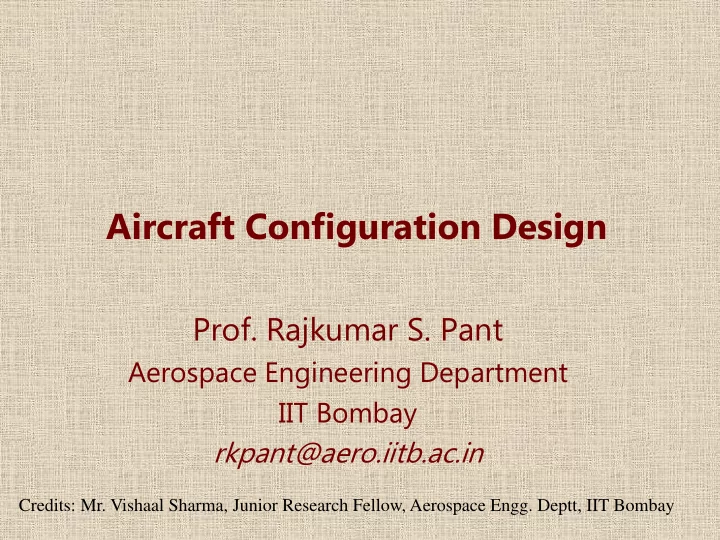

Aircraft Configuration Design Prof. Rajkumar S. Pant Aerospace Engineering Department IIT Bombay rkpant@aero.iitb.ac.in Credits: Mr. Vishaal Sharma, Junior Research Fellow, Aerospace Engg. Deptt, IIT Bombay
About William Bill Mason http://www.aoe.vt.edu/people/faculty/whmason.html
R S Pant The Boss A new capability Technology someone might advances? Designer pay to have? How to exploit technology for capability? Configuration Concept Airplane Shapes Have Changed to Exploit Advances in Technology
Configuration Concept: • Payload • Lifting surface arrangement • Control surface(s) location • Propulsion system selection • Landing Gear Wright Brothers: • Innovative control concept (more important than stability) • “Light weight” propulsion • Continual design evolution/refinement
Basic Laws of Airplane Design • Simplicity is the essence of true elegance— - it can also save weight and/or reduce cost. • If you can't build it, you can’t sell it. John McMasters Boeing Commercial Airplane Company
Beauty lies in the Eye of the Beholder “Dream Airplanes” by C.W. Miller, as shown in Fundamentals of Aircraft Design , by L.M. Nicolai
Features of Good Aircraft • Aerodynamically efficient, including propulsion integration (streamlining!) • Must balance near stability level for minimum drag • Landing gear must be located relative to cg to allow rotation at TO • Adequate control authority must be available throughout flight envelope • Design to build easily and have low maintenance costs • Should be quiet, and have low emissions
Key Technologies • Aerodynamics • Propulsion • Structures in the late 70s: • Flight controls in the 80s and early 90s: • Systems/avionics/observables & Manufacturing today: • the design process - (includes MDO) Amazingly Tricky to Integrate Advances in Each Technology
Conventional Subsonic: A Baseline • Payload distributed around cg • Longitudinal control power from tail (with moment arm) • Vertical Tail for directional stability, rudder for control • Minimum trimmed drag at near neutral stability • Wing/Fuselage/Landing Gear setup works Boeing 747-400, source: www.boeing.com
Layout Options Where do you put the wings? the engines (in fact, what kind?) Where do you put the control surfaces? what options are available? Do you have room for the landing gear? Possible innovative designs?
A few WHYs ?? Why podded engines below wing ? Why Swept wing ? Why Forward Sweep ? Why Variable sweep ? Why Canards ? Why Flying Wing ? Why Three-surfaces ? Why Winglets ? Why Thrust Vectoring ? Why ? Why ? Why ? Why ? Why ?
Why Put Engines in Pods on Wing? • load relief on wing: weight savings • access to work on engines (maybe) • safety • can be low drag Original idea by the British – in wing! If it’s small, can’t put them below wing Boeing Made Wing Mounted Engines Work
Why Sweep the Wing? Subsonic (usually small) • Adjust wing aero center relative to cg • On flying wing, get moment arm length for control Transonic (significant, 30 ° - 35 ° ) • Delay drag rise Mach (compressibility effect) - Definition of the Drag Divergence Mach no.? Supersonic (large, 45 ° -70 ° ) • Wing concept changes, must distribute load longitudinally as well as laterally • Reduce cross-sectional area and area variation Wing sweep increases wing weight for fixed span
Why Sweep the Wing Forward? X-29 SU-47
Why Variable Sweep? The F-14 Tomcat • Swept back: low supersonic drag • Unswept position: low landing speed on carrier, efficient loiter • Optimum sweep back available over transonic speed range • But: adds weight/complexity, currently unfashionable
Why Canards? • Trim surface carries + load for + ‘ g’ maneuvers • Reduces subsonic-supersonic ac shift (for forward swept wing this is good) • If balanced stable, C L on canard is much higher than the wing Drawback: downwash from canard unloads wing • • Acceptable high angle of attack lateral/directional characteristics hard to obtain When to use? • severe supersonic cruise/transonic maneuver requirement • Not Stealthy 1
Why a Flying Wing? Flying Wing Testing • Removing fuselage improves aero efficiency But, payload volume distribution is still an issue • Synergistic effect with relaxed static stability • Military: Stealth • Commercial: distribute load, reduce weight The B-2 Stealth Bomber but, limited cg range
Three-Surface Aircraft • If you can make a design with two surfaces, why use three? -Adds cost, weight, wetted area • Can trim with near minimum drag over wide cg range • Sometimes, efficient component integration can save weight Piaggio P-180 Avanti
Ferrari of the Skies ?
Recommend
More recommend